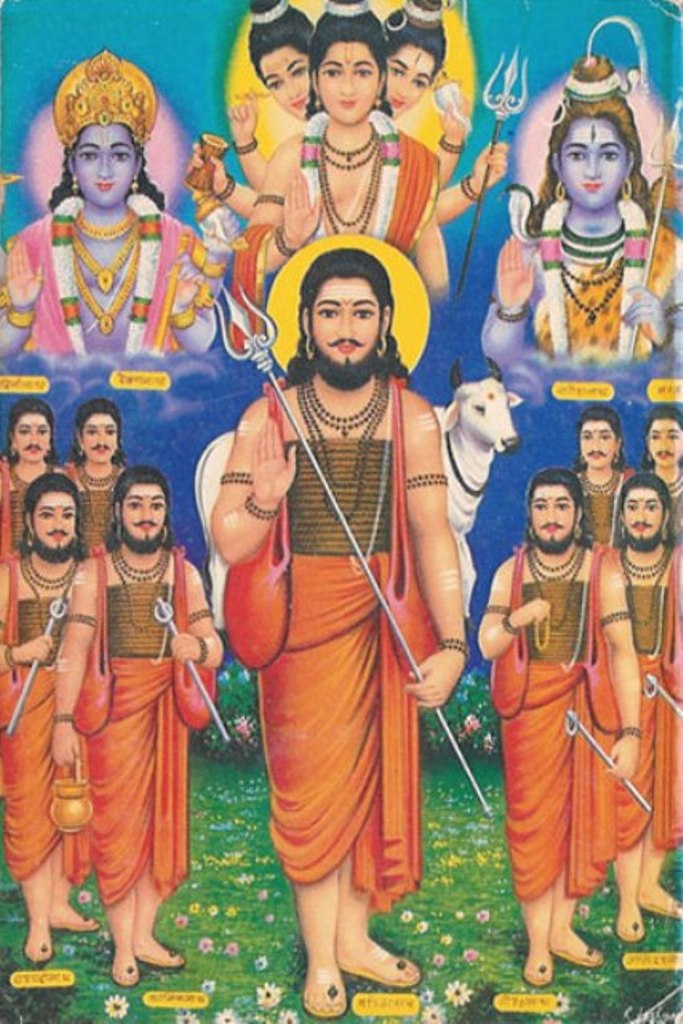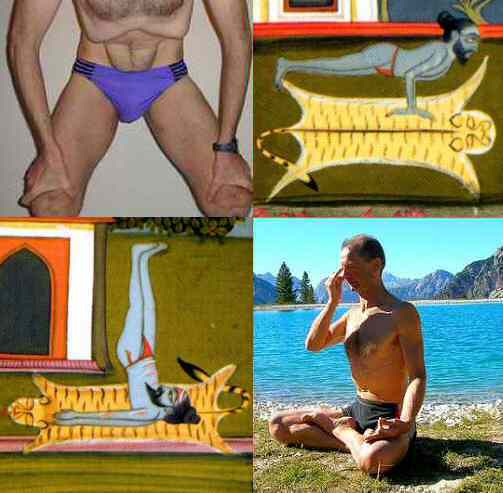|
Matsyendranath
Matsyendranātha, also known as Matsyendra, Macchindranāth, Mīnanātha and Minapa (early 10th century) was a saint and yogi in a number of Buddhism, Buddhist and Hinduism, Hindu traditions. He is considered the revivalist of hatha yoga as well as the author of some of its earliest texts. He is also seen as the founder of the natha ''sampradaya'', having received the teachings from Shiva. He is associated with Kaula (Hinduism), Kaula Shaivism. He is also one of the eighty-four mahasiddhas and considered the guru of Gorakshanath, another known figure in early hatha yoga. He is revered by both Hindus and Buddhists and is sometimes regarded as an incarnation of Avalokiteśvara. In the Siddhar tradition of Tamil Nadu, Matsyendranath is revered as one of the 18 Siddhars of yore, and is also known as Machamuni. The Kasi Viswanathar Temple in Thiruparankundram, Madurai, Tamil Nadu is home to his Jiva, Jeeva Samadhi. Early life Little is known about the life of Matsyendra: he is also ... [...More Info...] [...Related Items...] OR: [Wikipedia] [Google] [Baidu] |
Natha
Natha, also called Nath (), are a Shaivism, Shaiva sub-tradition within Hinduism in India and Nepal. A medieval movement, it combined ideas from Buddhism, Shaivism, Tantra and Yoga traditions of the Indian subcontinent.Natha: Indian religious sect Encyclopedia Britannica (2007) The Naths have been a confederation of devotees who consider Shiva as their first lord or guru, with varying lists of additional gurus. Of these, the 9th or 10th century Matsyendranatha and the ideas and organization mainly developed by Gorakhnath are particularly important. Gorakhnath is considered the originator of the Nath Panth. The Nath tradition has an extensive Shaivism-related theological literature of its own, most of which is ... [...More Info...] [...Related Items...] OR: [Wikipedia] [Google] [Baidu] |
Gorakshanath
Gorakhnath (also known as Gorakshanath (Sanskrit: ''Gorakṣanātha'') (Devanagari : गोरक्षनाथ / गोरखनाथ), c. early 11th century) was a Hindu yogi, mahasiddha and saint who was the founder of the Nath Hindu monastic movement in India. He is considered one of the two disciples of Matsyendranath. His followers are known as Jogi, ''Gorakhnathi'', ''Darshani'' or ''Kanphata''. He was one of nine saints, or Navnath, and is known in Maharashtra, India. Hagiographies describe him to be a person outside the laws of time who appeared on earth during different ages. Historians agree that Gorakhnath lived sometime during the first half of the 2nd millennium CE, but there is some disagreement about which century he lived. Estimates based on archaeological and textual evidence range from Briggs' estimate of the 11th to 12th century to Grierson's estimate of the 14th century. Gorakhnath is considered a ''Maha-yogi'' (or "great yogi") in Hindu tradition. He ... [...More Info...] [...Related Items...] OR: [Wikipedia] [Google] [Baidu] |
Navnath
The Navanatha (), also spelt as Navnath in vernacular languages, are the nine saints, Masters or Naths on whom the Navnath Sampradaya, the lineage of the nine gurus, is based. They are worshipped collectively as well as individually. Nine gurus Nath Sampraday believes Dattatreya, Rishi Dattatreya, an incarnation of the Hindu trinity Brahma, Vishnu and Shiva was its first teacher. Other traditions hold that Matsyendranath received initiation directly from Shiva, also known as Adi Nath. In many modern Nath groups, worship of Gorakshanath and Shiva is primary. The nine teachers, collectively known as Navnaths, are considered representative of great teachers in this tradition or parampara. Several lists are known:Nisargadatta Maharaj According to both Maurice Frydman, tra ...[...More Info...] [...Related Items...] OR: [Wikipedia] [Google] [Baidu] |
Hatha Yoga
Hatha yoga (; Sanskrit हठयोग, International Alphabet of Sanskrit Transliteration, IAST: ''haṭhayoga'') is a branch of yoga that uses physical techniques to try to preserve and channel vital force or energy. The Sanskrit word हठ ''haṭha'' literally means "force", alluding to a system of physical techniques. Some hatha yoga style techniques can be traced back at least to the 1st-century CE, in texts such as the Hindu Itihasa, Sanskrit epics and Buddhism's Pali canon. The oldest dated text so far found to describe hatha yoga, the 11th-century ''Amritasiddhi, Amṛtasiddhi'', comes from a Tantra, tantric Buddhist milieu. The oldest texts to use the terminology of ''hatha'' are also Vajrayana Buddhist. Hindu hatha yoga texts appear from the 11th century onward. Some of the early hatha yoga texts (11th-13th c.) describe methods to raise and conserve bindu (vital force, that is, semen, and in women ''rajas –'' menstrual fluid). This was seen as the physical esse ... [...More Info...] [...Related Items...] OR: [Wikipedia] [Google] [Baidu] |
Luipa
Luipa or Luipada (c. 10th century) was a mahasiddha siddhacharya from Eastern India.Ayyappapanicker, K. & Akademi, Sahitya (1997). ''Medieval Indian literature: an anthology, Volume 3''. Sahitya Akademi. , . Source(accessed: Friday March 5, 2010) He was a Buddhist saint from the Kãivartā community. He was a writer of a number of Buddhist texts and one of the early poets of Charyapada, a late Apabhraṃśa collection of poems. Nomenclature and etymology Although the Tibetan translation for ''Lui'' is "the fish-gut eater" (), the root of the word is probably Sanskrit ''lohita'' which means "red" and the names like Luidhar, Luichandra and Luiya mentioned in the ''Dharmamangal''s of the late medieval period originated from the same root.Sen, Sukumar (2002). ''Charyageeti Padabali'' (in Bengali), Ananda Publishers, Kolkata, , pp.20-1 Ayyappapanicker & Akademi (1997: p. 599) amplify the view of prior scholarship in that the nomenclature "Luipa" is related to the Brahmaputra R ... [...More Info...] [...Related Items...] OR: [Wikipedia] [Google] [Baidu] |
Hatha Yoga
Hatha yoga (; Sanskrit हठयोग, International Alphabet of Sanskrit Transliteration, IAST: ''haṭhayoga'') is a branch of yoga that uses physical techniques to try to preserve and channel vital force or energy. The Sanskrit word हठ ''haṭha'' literally means "force", alluding to a system of physical techniques. Some hatha yoga style techniques can be traced back at least to the 1st-century CE, in texts such as the Hindu Itihasa, Sanskrit epics and Buddhism's Pali canon. The oldest dated text so far found to describe hatha yoga, the 11th-century ''Amritasiddhi, Amṛtasiddhi'', comes from a Tantra, tantric Buddhist milieu. The oldest texts to use the terminology of ''hatha'' are also Vajrayana Buddhist. Hindu hatha yoga texts appear from the 11th century onward. Some of the early hatha yoga texts (11th-13th c.) describe methods to raise and conserve bindu (vital force, that is, semen, and in women ''rajas –'' menstrual fluid). This was seen as the physical esse ... [...More Info...] [...Related Items...] OR: [Wikipedia] [Google] [Baidu] |
Shaivism
Shaivism (, , ) is one of the major Hindu denominations, Hindu traditions, which worships Shiva as the Para Brahman, supreme being. It is the Hinduism#Demographics, second-largest Hindu sect after Vaishnavism, constituting about 385 million Hindus, found widely across South Asia (predominantly in South India, Southern India), Sri Lanka, and Nepal.Keay, p.xxvii. The followers of Shaivism are called Shaivas or Shaivites. According to Chakravarti, Shaivism developed as an amalgam of pre-Aryan religions and traditions, Vedic Rudra, and post-Vedic traditions, accommodating local traditions and Yoga, puja and bhakti. According to Bisschop, early shaivism is rooted in the worship of vedic deity Rudra. The earliest evidence for sectarian Rudra-Shiva worship appears with the Pasupata (early CE), possibly owing to the Origins of Hinduism, Hindu synthesis, when many local traditions were aligned with the Brahmanism, Vedic-Brahmanical fold. The Pāśupata movement rapidly expanded through ... [...More Info...] [...Related Items...] OR: [Wikipedia] [Google] [Baidu] |
Jalia Kaibarta
Jalia Kaibarta (or Jaliya Kaibartta, or: Jāliya Kaibbarta, possibly also: Jalia Kaibartya) is a community comprising people of low ritual status, fishermen, who later acquired respectable caste identities within the larger Hindu fold, helped by their commercial prosperity and Vaishnavite affiliations, through Sanskritisation.The census of 1901 interpreted the act of renaming as a ‘‘refusal of those at the bottom of the social scale to acquiesce in the humble positions assigned to them.’’ For Assam’s Dom fisher caste, previously at the lowest end of the ritual hierarchy, this refusal took the form of claims to Aryanist belonging through the new names of Nadiyal and Kaibarta. In colonial Assam the upper echelons of Dom society succeeded for the most part in acquiring new, respectable caste identities within the larger Hindu fold, helped by commercial prosperity and Vaishnavite affiliations. They are traditionally engaged in the occupation of fishing and boating and orig ... [...More Info...] [...Related Items...] OR: [Wikipedia] [Google] [Baidu] |
Siddhar
The Siddhar (Tamil language, Tamil (romanized) ''cittar)'' in Tamils, Tamil tradition is a perfected individual who has attained spiritual powers called ''siddhi''. Historically, Siddhar also refers to the people who were early-age wandering adepts that dominated ancient Tamil teaching and philosophy. They were knowledgeable in science, technology, astronomy, literature, fine arts, music, drama, and dance and provided solutions to common people's illnesses and advice for their future. Some of their ideologies are considered to have originated during the First Sangam period. Practice Siddhars were typically scientists, saints, doctors, alchemists, and mystics all in one. They wrote their findings in the form of Tamil poems on Palm-leaf manuscript, palm leaf manuscripts. They typically believe in Monotheism, one god, but there are some Siddhars who believe in polytheism. These are still owned by some families in Tamil Nadu and handed down through the generations, as well as bei ... [...More Info...] [...Related Items...] OR: [Wikipedia] [Google] [Baidu] |
Revan Nath
Shri Revan Natha, also known as Revan Siddh, Kada Siddha, and, Kaadhsiddheshwar Siddharaj was the 7th or 8th Navnath. He is especially worshipped in western India, where several temples are dedicated to him, and several sampradayas trace their origin to him, the best-known being the Inchegeri Sampradaya. Etymology Kada Siddha According to one account, Revan nath derived the name ''Kada Siddha'' from his siddhi, powers: Kaadhsiddheshwar According to another account, Revanath settled on the Siddhgiri hill for ascetic practice, living on whatever the jungle, gave him. He became famous known as Kaadsiddheswar * "Kaadha" means a jungle; * siddha, siddha guru, mean "one who is accomplished"; * "ishwar" means Shiva, the "Supreme lord". Meaning "the one who attained supreme realization in a forest". Biography Revan Nath was born at the bank of Reva River (Narmada River ), and was brought up at a farmer’s house. Mahima Siddhi One morning when he proceeded to his farm, Lord Guru Da ... [...More Info...] [...Related Items...] OR: [Wikipedia] [Google] [Baidu] |
Sampradaya
''Sampradaya'' (/ səmpɾəd̪ɑjə/,; ), in Indian-origin religions, namely Hinduism, Buddhism, Jainism, and Sikhism, can be translated as 'tradition', 'spiritual lineage', 'sect', or 'religious system'. To ensure continuity and transmission of dharma, various ''sampradayas'' have the Guru-shishya parampara in which a parampara or lineage of successive ''gurus'' (masters) and '' shishyas'' (disciples) serves as a spiritual channel and provides a reliable network of relationships that lends stability to a religious identity. Shramana is vedic term for seeker or shishya. Identification with and followership of ''sampradayas'' is not static, as ''sampradayas'' allows flexibility where one can leave one ''sampradaya'' and enter another or practice religious syncretism by simultaneously following more than one ''sampradaya''. '' Samparda'' is a Punjabi language term, used in Sikhism, for ''sampradayas''. Guru-shishya parampara Sampradayas are living traditions of both teac ... [...More Info...] [...Related Items...] OR: [Wikipedia] [Google] [Baidu] |








